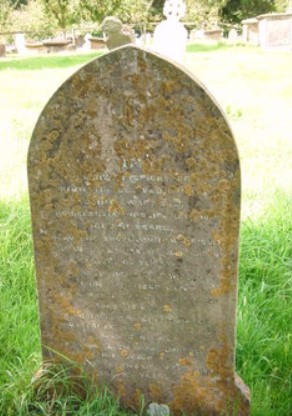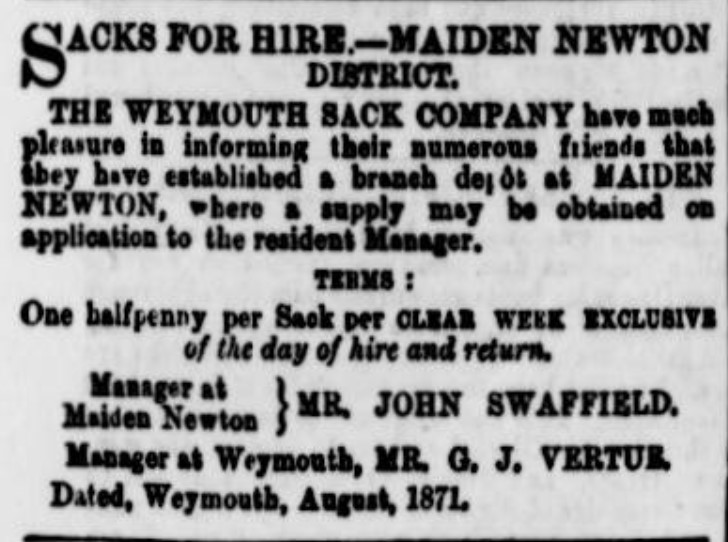Introduction
John Swaffield led a varied life. He spent his early years in Hardington, where he worked as a farmer in his twenties. Around 1834, he moved to Yetminster, where he became a baker and miller. Following the death of his wife in 1838, he returned to Hardington, where he stayed for about six years. He was later recruited by Lord Ilchester to serve as his farm bailiff at Moreton. During the final twelve years of his life, he worked as a corn dealer at Weymouth and a manager at Maiden Newton. His story includes the early death of his first wife from childbirth and the dispersal of their three daughters among relatives.
Early life at Hardington
John was born at Hardington on 17 May 1803, the only son of John Swaffield and his wife, Anne.[1] His father, a native of Haselbury, settled in Hardington after marrying in 1792.
The early deaths of both parents during John’s youth—his mother on 6 May 1823 and his father in July of the same year—forced him to mature quickly. He served as an overseer in 1825 and 1832 and a churchwarden in 1827, 1828 and 1830.[2]
In July 1830, an auctioneer recognised John’s talents and engaged him to show prospective buyers around five fields and a house offered for sale at West Coker.[3]
In 1830, John received an inheritance from his grandfather, amounting to £100, along with the right to rent properties, including Cary’s, for a period of 89 years at an annual fee of £40.[4] This inheritance provided John with a financial foundation and led to his inclusion on the voters’ lists for Hardington from 1832 to 1860.
On 5 April 1832, John married Harriet Brake at Closworth. The Brakes were a well-known farming family, and Harriet’s father, Henry, occupied 313 acres at Cowcroft Farm, Hardington. John and Harriet had two daughters at Hardington: Ellen Brake and Anne Bartlett.
Yetminster
In about 1835, John and his family moved to Yetminster, a parish closely associated with the Brake family, where John worked as a baker and miller.[5] They had two more daughters: Mary Elizabeth and Harriet. Tragically, childbirth complications led to the death of Harriet (the mother) on 7 September 1838 at the age of 26, and of Harriet (the infant) on 6 October 1838.[6]
Return to Hardington
After losing his wife, John returned to Hardington, where he resumed his trade as a baker. On 31 October 1840, after two years of widowhood, he married Jane Rugg at East Coker. Jane, the daughter of the recently deceased local farmer Charles Rugg, became the stepmother to John’s three daughters. However, their relationship was not close, as the children were largely cared for by the Brake family.[7] John and Jane had a daughter named Susan Rugg two years into their marriage.
In December 1841, John encountered a troubling incident that strained his relations with certain neighbours. After discovering that a hatchet and some coals were missing from his garden linhay, he contacted the village constable. The investigation implicated two local men: one whose shoes matched a distinctive footprint at the scene, and another who had the missing hatchet in his possession. The subsequent trial at the Wells Assizes resulted in a guilty verdict and a sentence of six weeks’ imprisonment for both men.[8]
Moreton
In about 1843, John, Jane and Susan moved to Moreton in Dorset, where John worked as a bailiff for Lord Ilchester.
Abbotsbury
By 1854, John had been relocated by Lord Ilchester to Abbotsbury, where his duties included overseeing the swan population.[9] In June 1857, John testified at Weymouth Petty Sessions against two individuals accused of poaching a swan.[10]
During John’s time at Abbotsbury, his daughter, Anne Bartlett, married John Humby, a tailor, at Southampton on 19 June 1855. Tragically, she died the following year, shortly after giving birth to her first child. This child, who was named after her mother, survived and was raised at Southampton by her paternal grandparents.
Wyke Regis
After leaving Abbotsbury in 1860 or early 1861, John and his family settled at 5 Bloomfield Terrace, Wyke Regis, where John had his own corn factor business with a store at 6 Bellevue. A court case of May 1861 provides a glimpse of his business activities, including the use of the railway to transport grain and visits to Yeovil market. The case report indicates that on Thursday, 25 April 1861, he engaged a man to carry 20 quarters of oats from Weymouth Station to Bellevue, after which he travelled to Yeovil market the next day.[11]
While at Wyke Regis, John experienced another instance of theft. On 10 February 1863, he discovered that a copper boiler and kettle were missing from his outhouse, only to later find them at a local marine store, where the thief had sold them. [12]
In 1869, John’s daughter Susan married George Peach, who was connected to the Swaffield family through marriage.[13] Following Susan’s marriage, her half-sister Mary Elizabeth took her place in the household.
Maiden Newton
By September 1871, John had become the local manager for the Weymouth Sack Company at Maiden Newton.[14]
John died at Maiden Newton on 22 January 1872 from apoplexy and was buried in the village churchyard.[15] His estate, valued at “under £200,” was administered by his daughter, Mary Elizabeth, as he left no will.[16]
Jane’s later life
John’s widow, Jane, moved to Montacute, the place of her baptism in 1802, where she died early in 1873, at the age of 70.
Children
Circa 1833- Ellen Brake (raised by her maternal grandparents; never married; lived with her aunt, Ann Read, for many years; died at Hardington in 1889 from apoplexy);
Circa 1834- Anne Bartlett (married John Humby, a tailor, at Southampton in 1855; died in 1856);
Circa 1837- Mary Elizabeth (raised by her aunt, Anne Brake; worked in Isleworth as a draper’s assistant; later lived with her father and, after his death, with her aunt, Ann Read; married Matthew Baker, the former landlord of the Duke of Edinburgh Inn, East Coker, in 1892; lived at West Stour and Gillingham; widowed in 1906; died at Weymouth in 1920);
1838-Harriet (died aged 5 weeks);
Circa 1843- Susan Rugg (married George Peach at Melcombe Regis in 1869; died at Weymouth in 1925).
References
[1] Hardington baptism register.
[2] Hardington jury lists.
[3] Sherborne Mercury, 5 July 1830, p.4.
[4] The will of John Swaffield, dated 28 August 1827, proved at Wells on 28 May 1830.
[5] Harriet’s grandparents, John Brake and Elizabeth Jesty, were married at Yetminster in 1776.
[6] Memorial inscription.
[7] Sherborne Mercury, 17 February 1840, p.3.
[8] Bath Chronicle and Weekly Gazette, 6 January 1842, p.3.
[9] Voters’ lists for Hardington and Haselbury.
[10] Dorset County Chronicle, 11 June 1857, p.5.
[11] Weymouth Telegram, 9 May 1861, p.4.
[12] Sherborne Mercury, 12 May 1863, p.2.
[13] George Peach was the son of John Peach, a Cattistock farmer. George’s mother, Elizabeth, was the sister of Richard Read, who married John Swaffield’s sister, Ann, in 1839.
[14] Weymouth Telegram, 22 September 1871, p.4.
[15] Death certificate of John Swaffield.
[16] Probate calendar.



